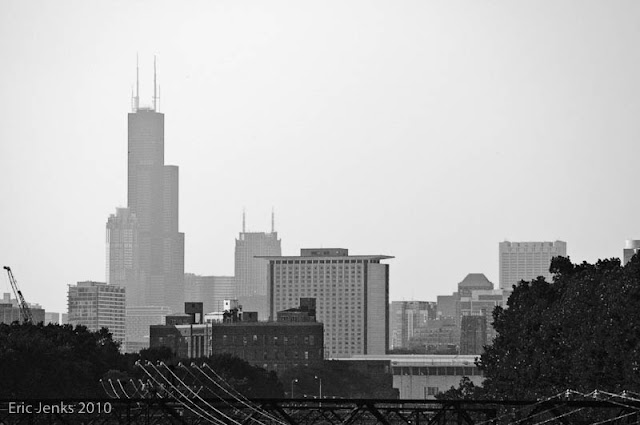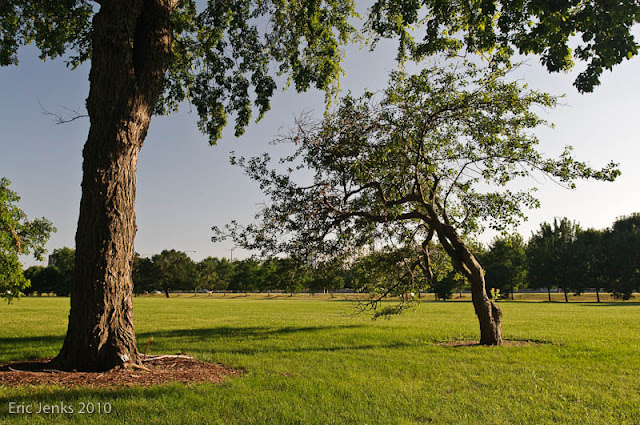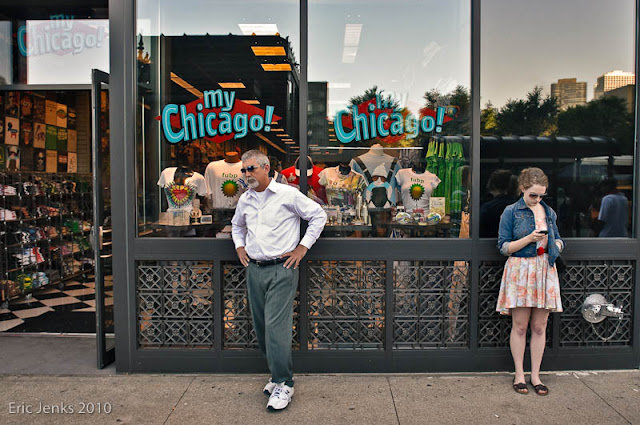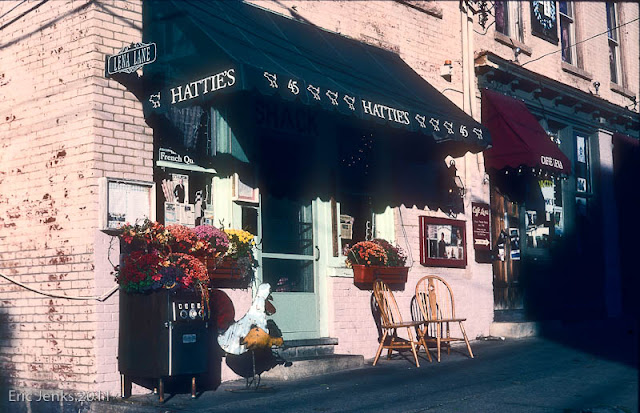While the vegetable farm is relatively new, it has multi-generational roots. “I was born into it,” said Leibig. “My dad, granddad, and great granddad either still farm or were farmers. I didn’t want to go into dairy. My great grandfather ran a multi-purpose farm where he had animals, a dairy, and grew vegetables. That’s more of what I wanted to get back to. I always liked working for dad. In high school I didn’t have a lot of interest in it. Pop culture wasn’t hip on it, it’s a lot of hard work and I’d see the struggle to make it work. So I wanted to try other stuff. I went to ACC for a year and got a job in Lake George at the pizza place for a couple years. I did some odd jobs, construction and stuff. I moved back here to work at the Kilpatrick Farm from 2013-2015.”
The move to Kilpatrick had to do with Leibig’s love of farming. “I just had a yearning for growing things,” said Leibig. “I felt homesick. This farm just drew me back here so I moved home. Then dad said something about Kilpatrick farm being a serious operation that I needed to check out. I liked growing vegetables, and learning about it. Kilpatrick farm was a fun environment, definitely not the 24/7 grind of milking cows, and as an employee I could walk away at the end of the day. Michael Kilpatrick was a good teacher and fun to work for, and I learned a lot. I started doing my own garden and going to the Dorset Farmers’ Market to sell on the side. When Kilpatrick moved to Ohio, I started renting his equipment and started my own operation with David Reeves Cochran on ten acres of leased land in Granville. But we went too big that first year and got burned out. Not enough energy and unfortunately the partnership deteriorated. It’s hard to keep that pace up when it’s your first time running a business. There’s a lot to learn.”
Deciding to regroup and change plans, Leibig brought the operation back to the family farm. “Why lease all of this land when we had this up here,” said Leibig. “My parents let us use the land and some of the buildings. So we installed hoop houses and turned one of the dairy barns into a wash barn.”
Leibig and Duignan started dating in 2016, but she didn’t join the farming operation until 2019. They have two children together, three and a half year old Elliot, and two year old Stella. “I’m from Wells, VT,” said Duignan. “I did not have a background at all in farming. I never would have guessed I would be farming, but I do love animals; chickens, pigs, ducks. I always wanted ducks. I even wrote an essay in high school on how much I wanted to keep ducks. They’re not really a money maker, we get about $7 dollars a week in eggs. But they’re fun and cute. I like the ducks better than the chickens. The ducks are easy to manage, the chickens go everywhere.”
Freedom of choice is a big reason why Leibig and Duignan work for themselves. “You have the freedom to do what you want,” said Leibig. “There are no issues or question about taking time out of the day if the kids need something. It’s nice being our own bosses, being in touch with nature, being outdoors, and providing food for ourselves and for everyone else. It’s a good feeling to be able to do that. At the beginning of fall it’s easy to be discombobulated and exhausted. There’s a lot of focus on the shoulders of the year for us, in spring and fall. Winter production is a big thing for us. Summer production is lighter for us than most farms. We ramp up to grow storage crops, and have tunnels for fall and winter greens. The competition decreases that way, since less farms have cold month offerings. By focusing on fall and spring growing, we can take some time off in the summer to do fun things with the kids and recharge. The farmer markets are year round though. It’s a marathon for us, so we’ve chosen to focus more on things that give us joy, that give us an income, and allow us a bit more freedom. What good is it to be the king of the world if you’re a slave to the grind.”
This project is made possible with funds from the Statewide Community Regrants Program, a regrant program of the New York State Council on the Arts with the support of the Office of the Governor and the New York State Legislature and administered by the Lower Adirondack Regional Arts Council (LARAC).
]]>
While the farm is 300 acres in size, Fuller and Hughes have concentrated their efforts on 20 acres of fields for their animals, and 60 acres of woods where they harvest maple syrup and grow mushrooms. “We’re having conversations with CCE and Farm Credit East about farm planning and potential credit needs,” said Fuller. We’re working on a business plan with CCE right now. We’re still fleshing out what we can do, how much money we need, and what profit we’d need to pay that back. Doing the stuff with the mushrooms means that we’re not taking any land or anything else from the dairy operation. We have an opportunity to grow while my dad is still dairy farming. It’s harder for me to expand to 50 sheep while my dad is doing 45 milk cows and raising heifers. There’s a lot of learning about how do you grow within the existing farm ecosystem. 20 acres give us that opportunity. We’re incredibly lucky to be on this land. We have a leg up that a lot of farmers don’t have.”
Fuller and Hughes moved back to the farm in March of 2020, after her grandmother moved into nursing care. “Everything happened at once,” said Fuller. “My mom had cancer starting in May of 2019, and passed away last March. At the same time my grandmother was getting sick and went into nursing care. After my mom passed, we started living here to be close to my dad and to be here. The farm has been in progress for years. The sheep had been at Tom’s parent’s house. It was a backyard farm on six acres. That March, we brought the animals here and started growing the flock. We’ve put our energy into the farm. Both as a way to distract myself and as something to put energy towards and do something productive.”
Both Fuller and Hughes currently maintain other employment besides the farm, with Fuller working in communications for American Farmland Trust, and Hughes working in construction.
“I was going to the Saratoga office for AFT, but since the Covid pandemic started I’ve been working at home,” said Fuller. “I can look out and see the lambs, and if there’s a problem I can deal with it. I’m here and able to take care of things as I need to, and not having a 50 minute commute is a real bonus. A lot of farmers have to have off farm income. My job is about farmers, and they understand if I have to cancel a meeting because a lamb is being born. There’s a lot of understanding and flexibility which I’m lucky to have.” Hughes has also been focusing some of his construction skills to the farm and the land. “Remodeling is easier than farming, but it wears on you,” said Hughes. “I’ve gotten an Alaskan sawmill that I’ve been using to make lumber, up to three foot wide slabs. It’s kind of hard but the results are cool. The trees have more potential than just firewood. It’s nice to use the resources that we have here to grow the farm.”
Fuller Acres is currently in a land trust to stay agricultural based, and Fuller and Hughes are looking at ways to bring more people out to the farm. “We’re not ready for agri-tourism yet,” said Fuller. “We’d like for people to come here and have an authentic farm experience. To go out and look for mushrooms in the woods when I feel comfortable leading walks and then buy meat, syrup, mushrooms, etc. from the farm store that we’re working on. We’d love to add farm stays for people that want to visit as long as it is permissible under the easement. In the future it would be nice to rent on Hipcamp and have a farm stay. We have beautiful land to share with visitors.”
For Fuller, it is important to keep her family’s legacy moving into the future. “I love this place,” said Fuller. “I can’t imagine it being gone or sucked up into someone else’s field crop. I’d hate to loose the integrity of this spot as it’s own place. The conservation easement is a way to keep this farm together for the future. I’m an only child. I always wanted to be back here, but didn’t know if it would be as a farmer. But I missed it a few years out from going to school. This place has continued to draw me back. You grow up in this lifestyle and it’s really special. It’s something that I didn’t want to let go of. This place has so much potential. I want to honor my dad’s legacy of farming for his entire life. But I want to do it in my own way, build upon what’s been done here, and leave it better than I found it. It’s hard to watch my dad struggle financially with the dairy. We can see how much we’re all struggling. The economics of it are stacked against us. I want my dad to be able to slow down a little bit and enjoy some sense of retirement and take care of himself. I want us to farm together and help each other so there’s more flexibility to take care of himself and ourselves. It can be complicated when we have different enterprises, but we’re working together and figuring out a way forward.”
This project is made possible with funds from the Statewide Community Regrants Program, a regrant program of the New York State Council on the Arts with the support of the Office of the Governor and the New York State Legislature and administered by the Lower Adirondack Regional Arts Council (LARAC).
]]>
Along with her mother, Pearle Roberts, and their four children, farming continued until 1985 when tragedy struck. “My brother Dan was killed in a car accident in 1985,” said Southerland. “It was a real turning point for the farm. They had 200 cows and heifers, and were mainly a dairy at that point. In the early 1970’s we still had 50,000 laying chickens, but with the price of eggs so low, they had moved out chickens and focused on the dairy. When my brother died, dad was done needing to farm.”
Southerland’s sisters followed in the teacher footsteps of their mother Pearle, who had taught English and French at Hartford and later Bethlehem Central schools. “Judy helps out two days a week here at Gardenworks, and is a retired English teacher. My sister Beth is a teacher resource assistant in Hudson Falls.”
From 1985 to 1991, the property was in transition. “Dad sold all the animals and equipment,” said Southerland. “He assessed the next idea of what he wanted to use the property for, and started planting blueberry bushes and fall raspberries. Our first crop was the raspberries, and about six to seven years later we started a u-pick blueberry farm. It was an all new use of land. We cleared out some of the farm buildings and started storing boats, cars, RVs, etc. It was the next chapter in figuring out how to use the farm buildings and move forward with a project but not needing to hire a real labor force. In 1992, we picked up the business and helped mom and dad with the picking, and helped manage storage. We did floral craft wreathes and arrangements, and little by little we added local handcrafts and artisan’s work. We also went on the road to a lot of juried craft shows. We always had farm pictures and a newsletter with us in an effort to do marketing. We would sell and market so that people knew that they could come and visit us. They could take a workshop in flower arrangement, wreath making and enjoy the farm and the products offered for sale. There were some great shows in Manchester, Larac in Glens Falls, and out in Shelburne, VT.”
Craft shows however weren’t a sustainable venue to keep Gardenworks thriving. “It got to a point where craft shows were declining and were not as lucrative,” said Southerland. “I had expectations of what I needed to make to support the booth fee and setup and keep the barn open, and unfortunately the shows weren’t getting there. So we started doing workshops, events, book signings, selling food, and being a gathering place for different events. Art shows, book signings, having other people giving informational talks and sessions on local products, etc. We involved the community. It’s fun to come and see what there is to see. And then we learned that we needed to have more inventory to support that interest. We couldn’t make everything that we needed for our clients. We continue to do local, but also bring in cheeses from the west coast and Hudson Valley. To make enough of a business out of it we needed to have the ability to order directly from companies.”
That community aspect is important for Gardenworks. “It feels good to be a part of the local community,” said Southerland. “The creamery helps us, and R.S. Taylor & Sons helps us, and so do other local businesses. We’ve always remained active in the chamber and tourism groups and the cheese and fiber tours that go through the area. To learn to be your own entity but to cooperate with other area businesses is an important thing. It’s important to recommend other businesses in the area. Any kind of packaging you can do to make people have a good time in Salem is important. You’ll hear them say ‘so and so would really like this, I want to bring them back here.’ It enriches the whole area. Our customers have become our friends. We love what we do. We love keeping the farm a farm, and fortunately our health and our help have allowed us to do that. We have a great team of helpers and workers and co-workers. They’ve become friends and extended family. They’re the people that help us achieve our goals.”
Each season brings a different crop to Gardenworks. The spring focuses on flowers, and Gardenworks’ greenhouse crop of annuals, perennials, herbs, and vegetables. “It all starts in the spring,” said Southerland. “Planting the fields with flowers for cutting, veggies for the year, and gourds, squashes, and pumpkins for fall harvest. In the summer, blueberries and our weekend cafe are a major focus. The cafe has taken off and is good. We haven’t picked up our farm to table dinners since covid-19 hit. The cafe has increased to the point where it would really push us to do those weekend dinners. In the fall we have raspberries, chrysanthemums, and a huge display of gourds, squashes, and pumpkins. That’s a time where we do our best to do recipes and food sampling. We’re trying to promote good recipes, nutrition, farm fresh food, and the value of knowing what you’re eating and discovering the flavors of truly ripe blueberries or garden ripe tomatoes and how good it can taste.
Looking towards the future, Gardenworks is again approaching a period of transition. Recently, their son Hunter, his wife Kelsey, and their children Walker, Joel, and Lila Pearle, moved back to the area. “We don’t know yet what the future holds,” says Southerland. “We’re exploring ideas. It reminds me of when Rob and I came back in 1990. Dad was tending raspberries and blueberries and that established a baseline. We developed interests and figured out where we wanted go from there to keep a farm a farm. Dad didn’t understand how you could keep a farm a farm with just greenhouse crops and a few vegetables, but supported us in that decision. With 600 acres to manage and feeding the cows and heifers to just the 8 acres that we typically focus on; his scale was very large compared to us. We’ve kept the land in the farm and put it all to use or rented fields to the creamery. Hunter finished his medical residency in family medicine last year, and it happened to be when the pandemic hit. They’re looking forward to living in the country and a garden bigger than they’ve ever had before. Kelsey home schools, and they’re active with other home schoolers and friends. Hunter is working for the Hudson Headwaters Network. There’s no plans set in stone yet, but we’re definitely thinking and envisioning about what can be. They need time to settle in, and see what is of interest for them on the farm.”
This project is made possible with funds from the Statewide Community Regrants Program, a regrant program of the New York State Council on the Arts with the support of the Office of the Governor and the New York State Legislature and administered by the Lower Adirondack Regional Arts Council (LARAC).
]]>
McEachron has spent most of his life on the farm, but did take a brief hiatus for college and several years after. “I grew up here with my parents Don and Tracy,” said McEachron. “Dad recommended that I go do something other than farming and go for something non-agricultural based for college, to make sure that farming was what I really wanted to do. That led me to Skidmore College in Saratoga. I studied business and economics there. I worked for Farm Credit East for two years after graduating in 2003. The plan was to work for four, but back in 2003, we were already looking around at the possibility of bottling our own milk. The dairy industry pricing is volatile, and lately it’s been just as bad. It got put on the back burner until 2006 when it was another bad year, and that was when we decided if we were going to to do it, we wanted to be the first ones in the area to start bottling our own milk. We started working on the creamery in September 2006 and by February 2008 we were bottling milk. We spent that time researching the process. We went to different places in the Northeast to see the process, and decided we were going to do it. We were already milking 350 cows and figured if anything, we would downsize the herd for the creamery. That didn’t happen though. By 2012 we were using all of the milk from the cows at the creamery. In 2013-2014 we were buying milk to supplement, and in 2015 we bought the second farm so we didn’t have to do that anymore. The parlor at the new farm was outdated and labor intensive there, so we decided to put robotic milkers in place in 2016. By 2019 we had 6 robots installed, which lets us milk 300 to 330 cows.”
For Battenkill, the growth was meteoric. “For the first eight to ten years, I don’t know how we grew as fast as we did and kept our head on straight,” said McEachron. “We already had a farm that was operating at a higher capacity than the creamery did which helped. The creamery just needed to run more and more. So we added more employees and grew the infrastructure needed to provide delivery options. Once we grew beyond the original size of the farm, that’s where the expense came. When I add 50 cows, that’s a $500,000 investment. That’s the cost of cows, the milking equipment, barn to house, land to feed, labor to manage, etc. It’s extremely asset intensive to produce more milk than we currently are. We doubled in size for the first three years, and didn’t have a year under 25% for the first ten years. And that 25% growth from year nine to ten was bigger than doubling the first two years. We’re really starting to growing again post Covid-19 too.”
Even with the growth, Battenkill remains family run. “My dad manages and oversees the home farm, he works down there majority of his time,” said McEachron. “I’m in the plant and harvesting crops. I mostly focus on the creamery and oversight of the other farm, but the farm manager down there makes it mostly self-sufficient. My mom Tracy does all the books. A few employees help out with receivables, but she does all the payables. It’s still pretty much all family, but good employees are what make it possible. We have around 40 employees between the creamery and two farms, with a few more in the summer for part time help. We’re born and raised doing it. It’s what we’ve always done. When you have the infrastructure for a 400 cow dairy, what is the other option. You either make it work or you have to sell. It’s easier to transition a 40 cow dairy to something else. But we have so much infrastructure it would be difficult. I felt that there was an opportunity to be successful if we could diversify and cut out the middle man and bottle our own milk, and that’s what we decided to do.”
Despite his father’s push to explore other options, McEachron always knew that the farm was where he wanted to be. “I always planned on coming back,” said McEachron. “I didn’t see anything else that drew me in the way this does. It was my gut feeling that I wanted to continue. I’ve never felt like there was a time where I didn’t want to go back to the farm. It’s rewarding that we can make something from scratch from the ground up. We grow the crops to feed the cows that we’ve raised since calves. We take care of them, and then they provide the wonderful product that we sell to the public. It’s nice to hear the feedback from people that they love what we make.”
This project is made possible with funds from the Statewide Community Regrants Program, a regrant program of the New York State Council on the Arts with the support of the Office of the Governor and the New York State Legislature and administered by the Lower Adirondack Regional Arts Council (LARAC).
“I’ve always wanted to document the world around me,” said Jenks. “I’ve had a camera in my hand since I could hold one. Growing up first in Vermont and then in upstate New York, the smell of a dairy farm is how I knew I was getting close to home. Any visit to my Great-Uncle Lawrence’s dairy farm in Fort Ann, NY, always included a stop in the barn to help out. From shoveling manure to moving hay, every hand was on deck. It didn’t matter if it was during a birthday or anniversary, the chores still had to be done, and I enjoyed being included that work. I was sad when I heard that Uncle Lawrence had sold the farm. Growing up, it felt like a place that would always be there.”
Jenks, who has had his work published for nearly 20 years, found it important to capture the changes occurring in the local agricultural community. “Farming is a hard way to make a living,” said Jenks. “By 2019, the average age of a farmer was fifty-nine and a half in the US. In 1945, it was just under 48. There’s a lot of factors involved with that change in age. As costs have increased, a lot of farms have consolidated, especially in the dairy industry. It’s hard to keep the smaller farms afloat in today’s markets. Costs have gone up, and a lot of farm grown products haven’t matched those increases. At the same time, we’ve seen rural communities shrink as urban areas have grown, creating a vacuum in the industry. All of that has culminated in what almost amounts to a lost generation of farmers.”
Working with local farmers’ markets and moving to Washington County showed Jenks that there is more to the story than an aging demographic may suggest. “It’s not just doom and gloom for agricultural communities,” said Jenks. “What I’ve seen, especially in the last five to ten years as a photojournalist, is an increased interest in living closer to the land. While many dairy farms have consolidated or disappeared, there is a new generation of farmers that are interested in working the land. They’re creating opportunities for themselves and their small scale, locally grown products, and it’s fun to see how they all do it in different ways. For my project, I tried to find farms that produced different products, and were also at different stages of generational transition at the farm. I wanted to show that while the face of agriculture in the county may be changing, the community that is integrated into its fabric continues to find a way to do what they love, and pass that passion on to another generation.”
Jenks’s exhibit focuses on Battenkill Valley Creamery in Salem, NY, Fuller Acres Farm in Fort Ann, NY, Fresh Take Farm in Granville, NY, and Gardenworks in Salem, NY. Battenkill Valley Creamery is a local dairy that has made their mark by bottling their own product for sale and making their creamery a destination for many with homemade ice cream. Fuller Acres Farm is currently transitioning from a dairy farm to a more diverse portfolio of cattle, mushrooms, and other meat animals. Fresh Take Farm transitioned part of the family farm from a traditional dairy to a thriving vegetable farm and CSA several years ago. Gardenworks is a diverse farm and farm store that was among the first to embrace agri-tourism in the late 1980’s and early 1990’s, and is currently facing the prospect of how to transition their business to the next generation.
“These farmers are my neighbors,” said Jenks. “I had someone ask me where I go to shop for food, living out in the country. My answer is where don’t I go to shop for food? I’m lucky to be surrounded by local farms that sell directly to consumers. You can’t get much fresher than greens that were harvested that morning. It’s wonderful to see the love and hard work that goes into raising animals. It’s a lifestyle that needs to be shared. I am beyond thankful for the opportunity to do so with the grant administered by LARAC, and to the Historic Salem Courthouse for providing a venue to showcase the work.
]]>
 The ViewThe view from my new home in Washington County, NY Photo By Eric Jenks
The ViewThe view from my new home in Washington County, NY Photo By Eric Jenks
Hi Folks,
I want to first say thank you to everyone that pitched in back in February towards my goal. I raised $1200 towards my car, and it helped a lot. I took home a 2012 Jetta, and it has been treating me well since the accident. I've healed up physically, and mentally I'm getting there. I still get weirded out a bit driving at night when I see headlights coming towards me, but it's not bad. For those of you who don't know, I was hit by a drunk driver in February. Thankfully I saw him swerve into my lane, and I was able to hit the brakes and ditch my car about 3 ft into a snow bank. The other driver is currently awaiting trial.
In the good news section of my personal life, I've met a beautiful woman, bought a house with her and asked her to marry me! Hopefully early fall next year we'll tie the knot on our property. The cover photo for this blog post is the view from our hillside. It's a bit like waking up on vacation every morning.
Now onto the photography!
 Jake and JuliaJake and Julia during their engagement session
Jake and JuliaJake and Julia during their engagement session
I've been crazy busy with work! A good thing. I've picked up a few new clients in the journalism world (New York Daily News being the largest), and I've also been transitioning more into the private sector with weddings, engagement shoots, portraits, and event work. I have to say I like the change. I get to be involved with my clients more, it's a bit less stringent on deadlines (I rarely get called to shoot a wedding the day before!) so I know my schedule more in advance, and it's fun work. With the giant barn on the property, I'm working on building a studio inside for rainy day shoots.
 Dorset QuarryThe old marble quarry in Dorset, VT Photo By Eric Jenks
Dorset QuarryThe old marble quarry in Dorset, VT Photo By Eric Jenks
My personal photography has been focused more on landscapes lately than on people, and capturing the things that are nearby my new home in Washington County, NY. I've been traveling with my leica more than a DSLR, and it is liberating not to haul around 30 lbs of gear to take shots. The M8 is going strong, though recently I've returned to film with a Contax IIa Color Dial from 1956. Film had been put on the back burner for quite a while due to time and money, but I'm hoping to shoot more in the near future. Waiting on the return of film from a trip to the botanical gardens in NYC, Landscapes and portraits with my Hasselblad, Rollieflex, and Nikon F100. Precision Camera is doing the processing and scanning, giving me 25 MP scans from the negatives. Not too shabby. I've got quite a bit of B&W to finish up too, which I'll have processed locally at McGreevy down in Albany, and scan myself. It's just fun to be able to make photographs with equipment that is from the 1950's or older. If you've never shot film, you should give it a go. You might find it rewarding to have to wait to see how your vision has been realized.
 RootsRoots of a tree by Auger Falls in Hamilton County, NY Photo By Eric Jenks
RootsRoots of a tree by Auger Falls in Hamilton County, NY Photo By Eric Jenks
That's all for now,
Eric
]]>I'd like to raise some additional funds with my photography, with a goal of $1500. For the next two weeks, all prints on my website (www.awasos.com) and my photographic services will be 20% off. If you need portraits, have an event, headshots, business photos etc. I can do them for you and you can save compared to what I normally charge. All you have to do is hire and pay me in the next two weeks, and I'll be available for your event whenever you'd like to schedule it this year.
Here's the fun part. If I do raise $1500 or more, I'm donating 20% to MADD (Mother's Against Drunk Driving). http://www.madd.org/. I'm happy to be alive, and I figured this would be a pretty sweet way to give back to the world. So if I raise, $1500, I'm donating $300, and so forth for any amount above that.
So please buy a print, hire me for some work, or share it with friends that are interested. I appreciate any and all help in getting a reliable car again. The Coupon code for my website is MADD.
]]>
 Me with my new M8With the Voigtlander 35mm Color Skopar f2.5 wide open.
Me with my new M8With the Voigtlander 35mm Color Skopar f2.5 wide open.
I rarely purchase anything twice. Once I've sold an item, I really don't harbor regrets. Photography for me is a release, but it's also a business and I buy gear that A. Works, B. Makes Sense, and C. is enjoyable to use. If it doesn't fall into those categories, I send it on down the road. The Leica M8 that I purchased in 2012 just wasn't that for me. It didn't work properly (sent back to Leica twice), I had traded my M3 towards buying it (a regret that I rectified through the seller when I returned the camera) and wasn't enjoyable to use because I was so worried that it would have another camera fault. In short it was a headache for me.
So it went back, but I grew to wish that I had it again. I loved the files, I loved the compact nature of the camera and I love shooting with rangefinders. As a background, I've shot with rangefinders for fun since 2007. My first was a gift from a college professor, and I've been hooked since then. The interface to me is better than using a bulky SLR for most things. They're mechanical gems that are a joy to use. They pare photography down to its basic essence, and they've taught me a lot about the craft. Most of my Leica gear is ancient in photography terms (read: the 1930's, 40's and 50's). I can't afford the latest offerings, as tempting as they are. Leica is often seen as a luxury brand now, which unfortunately is a bit true with some of their "collector editions" that they put out from time to time. If you look at the history of the brand, their gear has never been cheap. It is really expensive to make a proper rangefinder, and to have it made in Germany at that. There are enough third party and used accessories and lenses for the system that you don't have to spend a fortune to shoot with Leica cameras. Voigtlander and Zeiss (made by Cosina in Japan) are both wonderful companies that offer some amazing glass for Leica cameras at a more reasonable price.
 The Infamous StringdustersPutnam Den, with the Voigtlander 35mm f2.5
The Infamous StringdustersPutnam Den, with the Voigtlander 35mm f2.5
Realistically, unless I'm shooting sports, I don't need AF, I don't need hundreds of shots taken of the same subject at 10 FPS. For work I shoot a lot with a Nikon D3, 28-75 f2.8 zoom and a 80-200 f2.8 zoom with a couple of flashes, 17-35 f2.8 for tight spaces, and some other accessories. It gets heavy, and is honestly overkill. My neck hurts, and I'm just not really willing to carry it around for my own personal photography. I often need to have a digital camera on me for spot news, so my film cameras have been sitting back at my apartment, waiting to be used.
 Greenwich FallFrom my bedroom window, Leica 50mm Summicron Collapsible, f5.6
Greenwich FallFrom my bedroom window, Leica 50mm Summicron Collapsible, f5.6
Fast forward a year and a half, and I'm back with the M8. This time I did not sell the M3, as prices have dropped to a point where it wasn't necessary for me. I also bought from a dealer with a 1 year warranty, and it had just come back from Leica with a fresh CLA. (Bonus, I'm getting a couple of free filters from Leica). It's in great shape and it confirms that I've been missing out on the rangefinder experience for work and for fun.
I couldn't justify an M9, ME or M(240) to myself. They're all just too expensive for what I would be receiving out of them. I would prefer full frame to the crop sensor on the M8, but 1.3x is not a huge crop and I don't find it too restricting. A used M9(P) runs $3600-5200. A new ME is $5,000 and the M(240) is a whopping $7,000, if you can find one. Both the M9 and ME are incremental increases in technology over the M8, in my opinion. A great increase if you need full frame, but not in terms of IQ, noise, etc. At least for what I do. The M would be wonderful, but it's close to four times what I paid for the M8. Perhaps in 5 years or so an M will come my way, but for now the M8 is a wonderful entry into the world of digital rangefinders. Frankly, it's price puts it into a range where I'm not worried about using it and damaging it. For those of you that would suggest a Fuji Xpro instead, I say that's a valid camera, but not really what I'm looking for. I want the rangefinder, not an AF camera that looks like one.
 Today's SpecialMy friend Dave Farnsworth at work. 50mm Summicron Collapsible @ f2.8
Today's SpecialMy friend Dave Farnsworth at work. 50mm Summicron Collapsible @ f2.8
There is a quality to the file from the M8 that I just love. Besides having fantastic colors, I've found that I can convert the RAW files into some of the best B&W images that I've ever made. The camera almost cries out to be shot in B&W with subjects. The lack of an anti-aliasing filter and super thin infrared filter means that the images are crisp and sharp. Yes I use IR filters on the lenses, but I mounted UV filters on my Leica glass anyway, so it's not a hassle.
 Congress ParkTaken with the Summicron 90mm f2 from the 1950's. At f2.8
Congress ParkTaken with the Summicron 90mm f2 from the 1950's. At f2.8
The "downfall" of older digital gear is usually its high iso files. [WARNING: Techno-babel about to commence] I will agree, it definitely has more noise than my D3. I can push the D3 into the stratosphere if I need to. A difference though is my prime lenses with the M8 means I don't need to push the ISO limits as hard. For example, the 80-200 f2.8 has a lot of elements (18 elements in 14 groups). This leads to light loss, no matter how good the coatings are. About a half a stop or so in my experience compared to a 6 or 7 element prime lens. So it makes it the equivalent of about an f3.5 lens in terms of the amount of light that gets in. Compared to an f2 lens then, I can get about 1.5-2 stops more light on my subject. Also since the M is a bit more compact and doesn't have the mirror slap, I've found I can shoot at a slightly lower shutter speed compared to with an SLR. where I would require an 80th of a second with the D3, I can usually get away with a 1/40th or slower with the M8. The result; I don't need ISO 2500 with the M8 unless its a black cat in a coal mine.
My two systems complement each other; I use the D3 when I need telephoto, super low light, speed, etc. I use the M8 when I just want to have something that is small, lightweight, and works. It's great for photojournalism, concerts, and general photography. In short, I've taken more photos for myself in the last month than I think I have in the last 6 months. And realistically, the best camera is not only the one you have on you, but the one that makes you want to take a photo. Rangefinders are what do that for me right now, and the M8 seems to be doing well by and large in that category for me. I'll still keep and shoot the M3, M6 TTL, etc. that I have. Variety is the spice of life, haha. But it's nice to know that when I go out the door, I have something that I can shoot for fun or shoot for work on me. I also find that subjects seem less tense around the smaller camera, though I'm not sure it's because they assume I'm shooting film (I think I've gotten that about 15 times since I've been out with the camera this month) or simply because it's not as big as the D3 with lenses, SB 900 flash, etc. As a six foot two inch man built like a linebacker, I'll never be inconspicuous while taking photos.
 Writing Peace in ChineseAt a Peace Fair in Saratoga Springs. Voigtlander 35mm f2.5 @ f4
Writing Peace in ChineseAt a Peace Fair in Saratoga Springs. Voigtlander 35mm f2.5 @ f4
That's all for now,
Eric Jenks
Awasos Entertainment
P.S. If you've enjoyed what you've seen, consider purchasing a print! All of my images are for sale, and I use my camera to pay my bills. Nothing makes me happier than to see an image go to a home where it belongs, and you'll have the satisfaction of supporting a working artist instead of purchasing mass produced art from department stores.
]]> Arnold's Farm. Greenfield Ctr, NYPhoto By Eric Jenks
Arnold's Farm. Greenfield Ctr, NYPhoto By Eric Jenks
Welcome back readers and viewers! It's been quite the delay since my last post, for which I apologize. Life has a habit of getting busy, for which I'm both grateful and bummed at sometimes. I've been super busy with working for a bunch of clients (I believe I was in 8 different publications in August) and I've been traveling all over the country and the world since my last post. I wanted to touch upon a subject that is near and dear to the hearts of anyone that lives in the Northeast this time of year: Autumn and the changing of the leaves.
 Maple and EvergreenIn Acadia National Park last fall. Photo By Eric Jenks
Maple and EvergreenIn Acadia National Park last fall. Photo By Eric Jenks
It's amazing to me to see how the landscape flourishes during the lasts moments of warmth that we'll have before the winter comes upon us. The bright colors seem an act of defiance by Mother nature in the passing of the seasons, one last go to show that the beauty of life isn't taken without a fight (yes I realize that all of this is happening as chlorophyll and other chemicals in plant cells are reacting to colder temperatures and less available sunlight, but that's nowhere near as fun to talk about).
I recently moved to Washington County (Greenwich, NY to be exact) and I've been granted a view into the autumnal passage that farms take as well. While yes, there are farms in Greenfield, the ones that I would see are more animal in nature rather than plant based. Here in the floodplains of the Battenkill and Hudson, the corn fields have been shucked and cleared for the season, leaving behind furrowed lines like wrinkles in Mother Nature's face.
 Salem FarmlandThe cleared fields next to the Battenkill Creamery in Salem, NY
Salem FarmlandThe cleared fields next to the Battenkill Creamery in Salem, NY
I've also noticed in town that just about everyone puts a pumpkin by their front door. I feel a bit as if I've moved back to Vergennes, VT, and I'm enjoying the small town formalities that I get to see everyday.
 2013Fall-27Photo By Eric Jenks
2013Fall-27Photo By Eric Jenks
In the past, my personal fall photography has been focused primarily on landscapes in the wilds of the North Country. I've wandered through the mountains, spent a week in Acadia National Park, and otherwise set out to get away from others during my search for the fall color. It's a bit of a nice change to focus on a town and focus on farm life. I seek out interesting compositions, good color and great light when I do my photography. If any of the above aren't present, it's not going to be a good photo. As a result, I try to wait until earlier in the day (closer to dawn) or later in the day (an hour before sunset) to take my photographs. Less contrast, better saturation to the colors, etc. Polarizers are also a well used piece of equipment, as they can help to reduce glare off of leaves and really pull in the color and darken up blue skies. A good cloudy day though is also key; Some of my favorite fall photos are taken when the sun refuses to play nice and come out.
The most important aspect for me though is to enjoy. I just like keeping my eyes opening and taking in the beautiful landscape that I live in. If I take a photo, great. If not, at least i got to enjoy the little things that make life a brighter place. And on that note, Good day! Go enjoy the color while it lasts. It's more ephemeral than any flower in the spring, and just as beautiful to me.
]]>
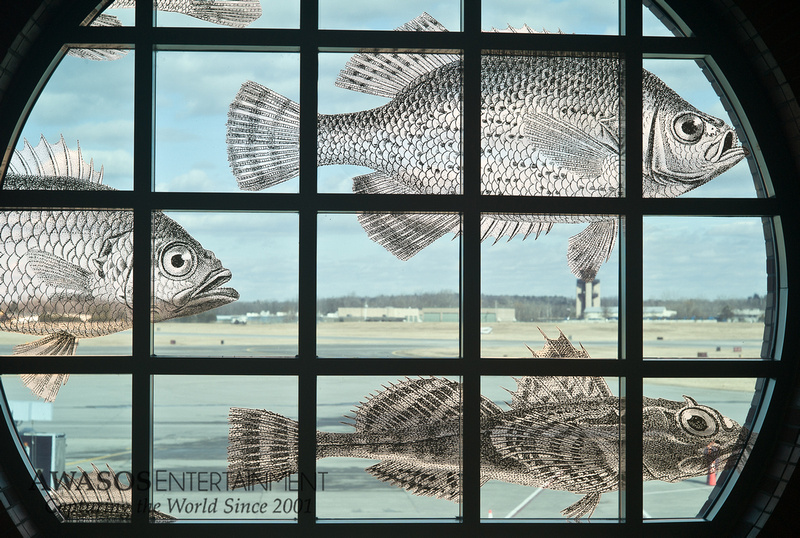 |
| Albany, NY Airport. Leica M8 50mm Summicron |
 |
| Paris Cityscape, from Tour Montparnasse. Leica M8, 90mm summicron |
 |
| View from the Louvre, towards Arc de Triumphe Carousel and the Eiffel Tower. Leica M8, 50mm Summicron |
 |
| A Frenchman's Lunch. Marches des Puces, St. Ouen. Leica M8, 50mm Summicron |
 |
| Père Lachaise Cemetery, Paris. Leica M8, 50mm summicron |
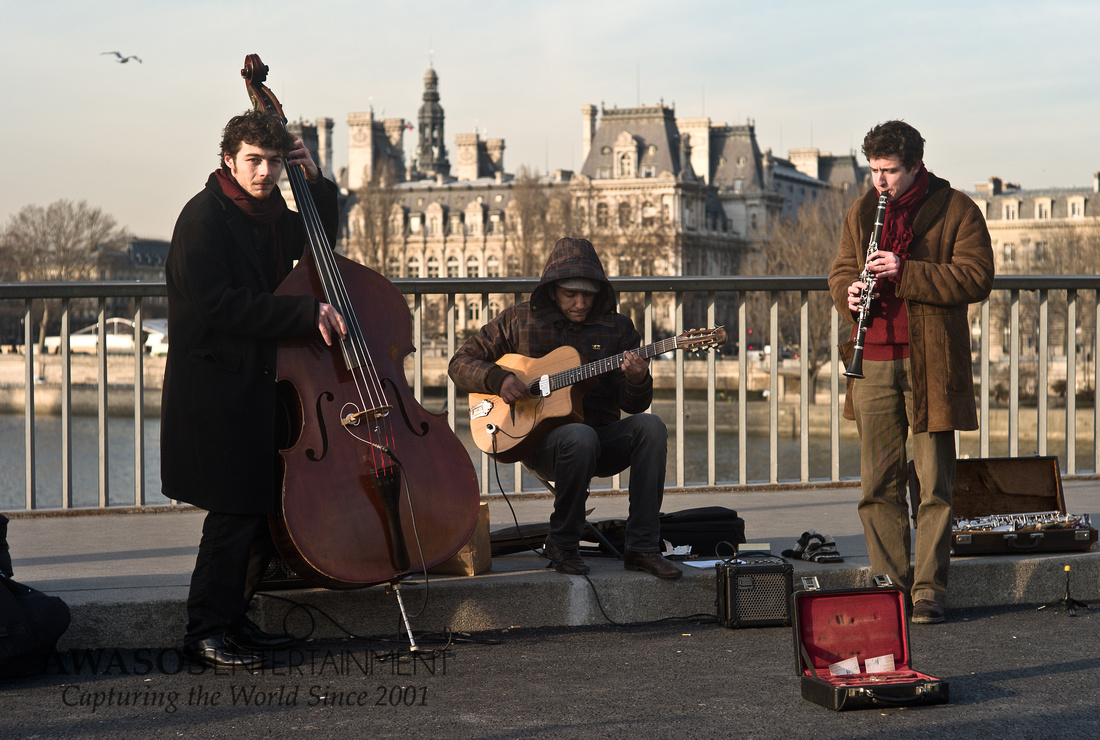 |
| Pont de l'Archevêché, near Notre Dame. Leica M8 50mm Summicron |
 |
| Chateau de Versailles. Leica M8 35mm Voigtlander |
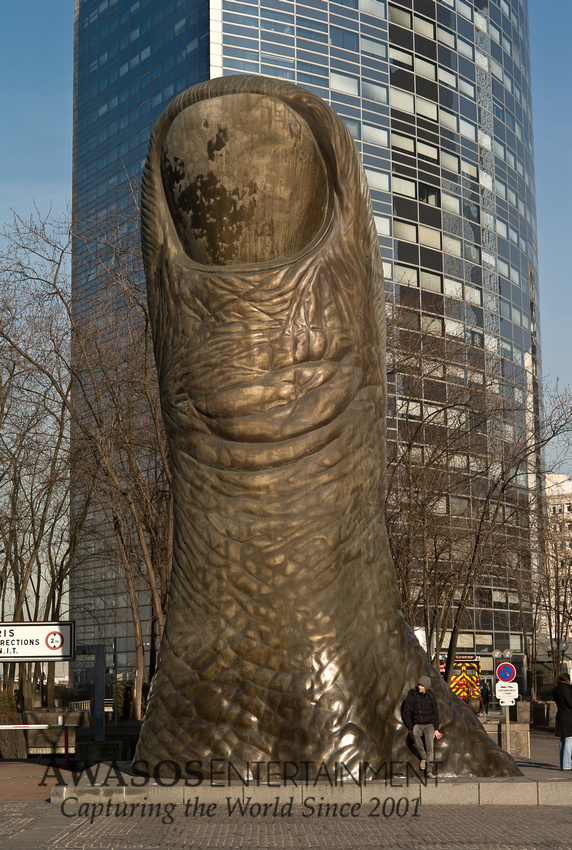 |
| Thumbs Up; La Defense. Leica M8 50mm Summicron |
 |
| Le Marais, 3rd Arrondissement, Paris. Leica M8, 50mm Summicron |
 |
| Musée Carnavalet Garden, Le Marais. Leica M8 50mm Summicron. |
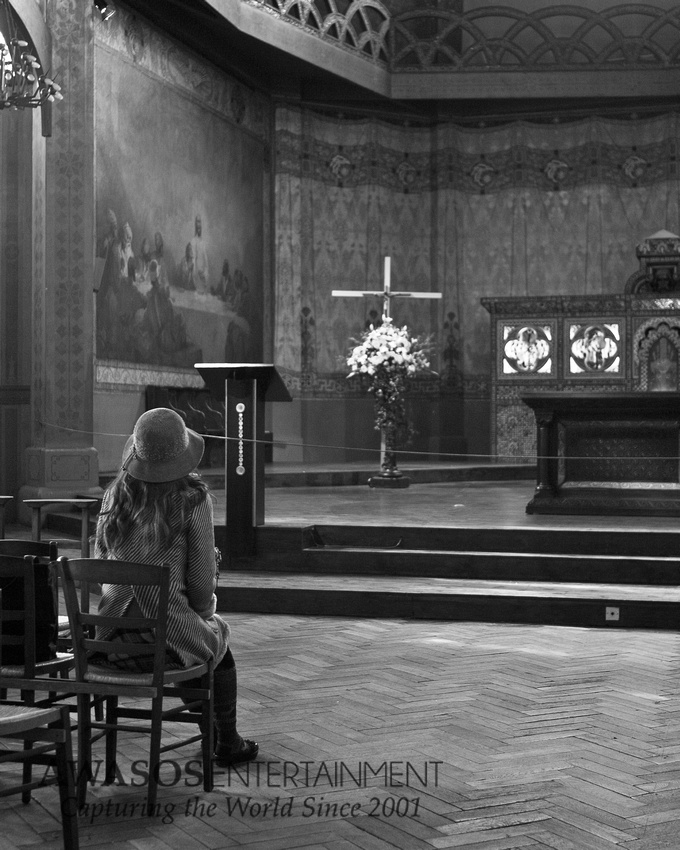 |
| Notre Dame, Montmatre. Leica M8, 50mm Summicron |
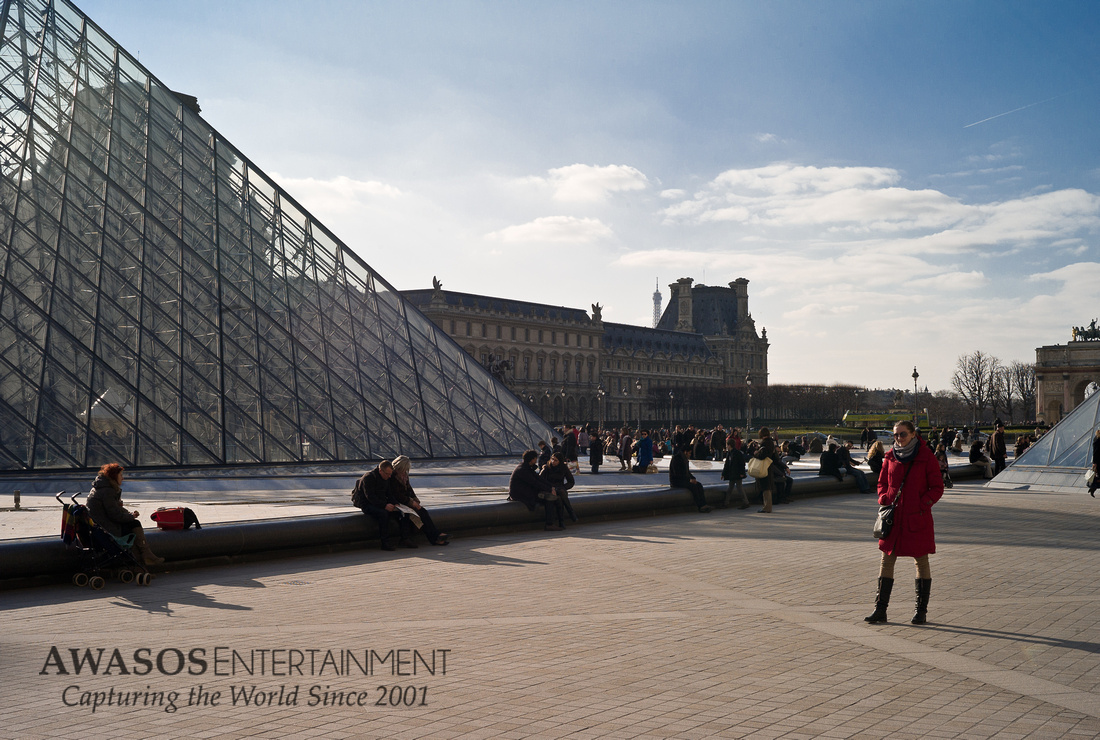 |
| Ilona Mikhailiv (in red) at the Louvre. Leica M8, 35mm Voigtlander |
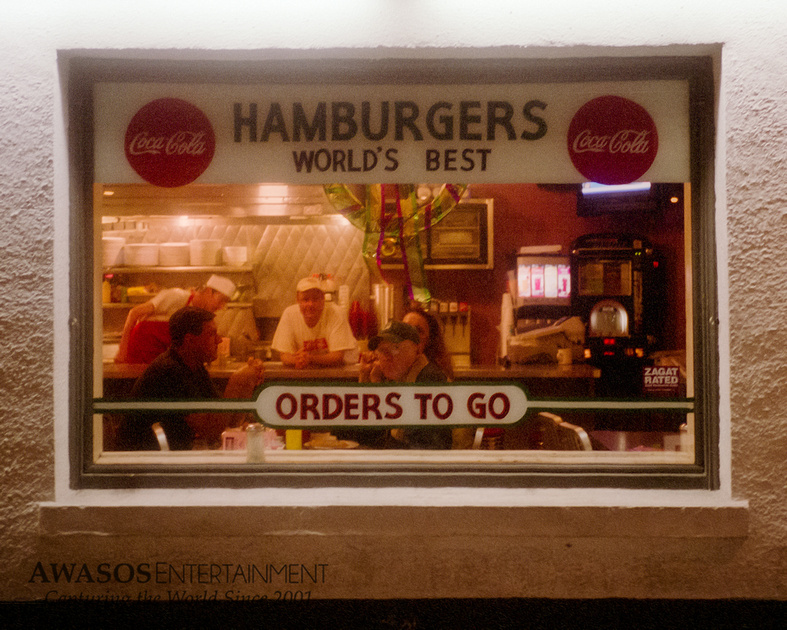 |
| Hamburger Joint in the French Quarter. Leica M6TTL, Fuji Pro800. 50mm Summicron |
I had the chance to stay with some amazing folks while I was in New Orleans - Adrian, Giselle, Ronnie, Jaime, Matt and co; thank you so much for the hospitality and making me feel welcome in your lives or in your home. Without all of the wonderful people I met during this trip, I wouldn't have had the incredible experience that I did. For the eight days that I spent in the city, you made me feel like I had lived there all my life.
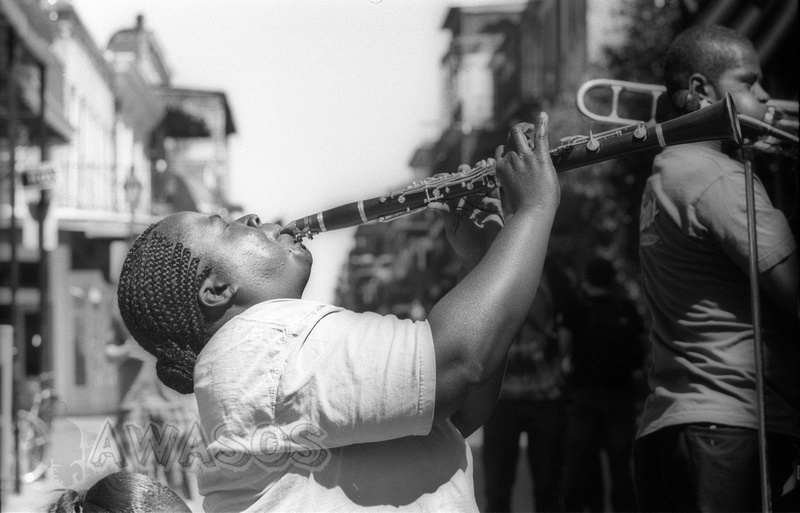 |
| Street Performer, Royal St, French Quarter of New Orleans. Leica M3, 90mm Summicron, Tri-x. |
There were a few ways that I could have tackled the city when I went to take my photos. I will admit, I fell trap to the lure of the French Quarter and it's easy tourist attractions. I hope however for the most part that I can show a side of New Orleans that in often years has been overlooked; the jovial and bright nature of its residents.
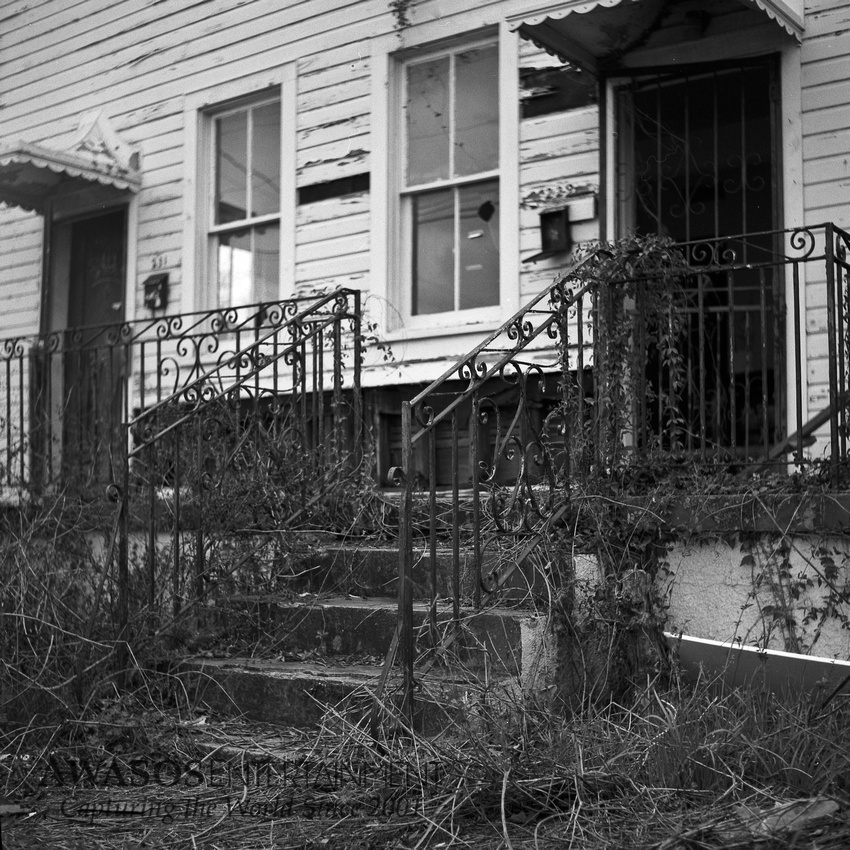 |
| House a mile outside of the French Quarter. Still abandoned after Hurricane Katrina. Rolleiflex MX-EVS, Kodak Plus-x 125 |
Hurricane Katrina has left its mark for certain; but the populace of the city has not been beaten. What my photo above fails to show is the home next to it being renovated for a new family. Streets are still crowded with performers, tourists and residents going about their lives and enjoying what this city has to offer. It is unlike just about any city I've ever come across in the United States. I've been told that my photos of it seem more like a spot across the pond then here.
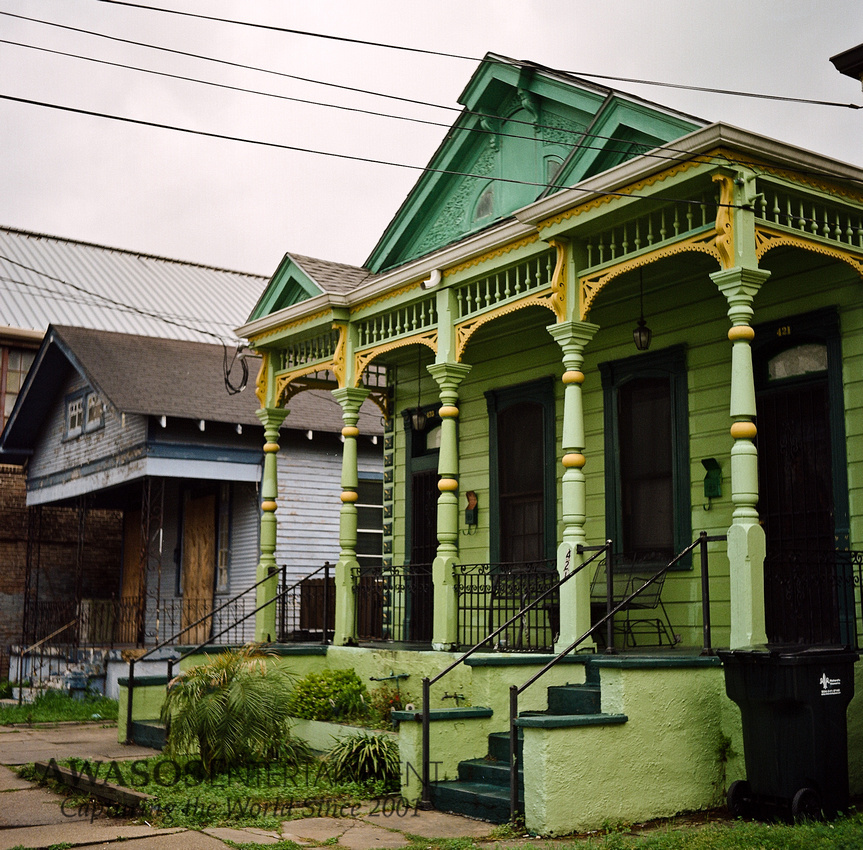 |
| Renovated Home, New Orleans, LA. Rolleiflex MX-EVS Kodak 160 NC |
 |
| French Quarter Hotel. Leica M3, 50mm Summicron, Yellow Filter and Tri-X. |
The architecture of New Orleans is great. I loved looking at the different buildings and the variety of things compared to where I live in upstate NY. 15 foot ceilings don't happen around here (at least not if you want to stay warm in the winter). The bright colors and stucco'd appearance of many of the places just isn't what I'm used to. Some spots in the French Quarter definitely evoke an old world feel, with dark colors, gas lanterns and hidden gardens that jump out behind gated entrances. Visiting Mimi's made me feel like I was in bombed out Europe during the 1940's (aided in part I'm sure by the klezmer band that was rocking the second floor) with plaster falling off the walls to reveal the brick and wood underbelly of the building.
It is the people however, that make New Orleans into the intricate place that it is. An amalgamation of its parts, New Orleans is both Modern and Antiquated in the same breath. It is home to the musicians that revel in the music of the teens, twenties, thirties and forties. As one of my friends put it, "You know the home of misfit toys? Well here we're the home of misfit instruments." Sousaphones, archtop guitars, bass saxophones and a variety of other, stranger instruments reign supreme here. Yet modern jazz, rock, blues, and the ever-present singer songwriter find their place here as well. The 1940's streetcars still run (rarely on time, but the whole city is laid back about things like that) yet visitors are looking up destinations on their smart phones. The antique charm of the French Quarter is offset by the Neon blitz of Bourbon Street, home to flashers, booze and strip joints galore.
 |
| Bourbon Street at Night, Leica M6ttl, Fuji Pro800 35mm f2.5 Voigtlander |
The party truly never stops for some visitors and residents, especially around Mardi Gras. It's a bit weird and sad to see people still hammered at 10:00 the next morning because they haven't stopped going to the bars.
 |
| American White Ibises in a Tree in City Park. New Orleans, LA. Rolleiflex MX-EVS, Kodak Plus-X 125 |
Being a country boy though, I do have to try and find some sort of natural setting in every city I go. I've done it in New York, LA, Boston, Chicago, Montreal and New Orleans. After a few days. I get tired of concrete and metal and I need some nature. City Park was a nice destination for that in New Orleans. It still has playgrounds for the kids, concrete walkways and such to make city people feel at ease, but the variety of birds, turtles and other random animals makes it a fun place to reconnect for a moment. Spanish moss in the trees doesn't hurt as well. I took my Rollei out to explore here and it was a lot of fun. One of my favorite photos is of this twisted up tree in City Park. I just love the tones and the feel of it for some reason.
 |
| Tree covered in Spanish Moss in City Park. Rolleiflex MX-EVS, Kodak Plus-x 125. |
I could easily keep going about the trip; I've left out so much, from spanish grocery stores to cactus steaks for dinner to random crawfish boils at midnight with strangers. I'll stop here though and say one thing; Go! If you've ever wanted to visit for the Jazz fest (more rock than jazz these days) Mardi Gras, or just to see this amazing city, don't wait. Do it. Get out of the hotel area, buy a pass for the street car and explore the city. It's worth it. I haven't even touched on how great the parades are that they have.
 |
| Marine Band during St. Patricks Day Parade. Leica M6TTL, 50mm Summicron, Fuji Provia 100 |
(Thanks for reading. If you've enjoyed the post, the photos or anything else, please feel free to visit my website, www.awasos.com. Photography is what I do for a living, and without wonderful folks like you purchasing prints, hiring me for events, or anything else photo related I can't travel to wonderful places like this and take photos. If you'd like to see more photos from New Orleans, you can click here to go to that album directly - http://ericjenks.zenfolio.com/neworleans.)

|
| Photo Credit, Meaghan Carney 2012 |
It's a question I get asked a lot. I still shoot with a Rolleiflex, Leicas, Nikons and most recently a Hasselblad. I get asked the usual questions - where do you get film for that? Do you have to process it yourself? and (usually by other photographers) why?
I get film at a variety of places - CVS (they still have tri-x!) Adorama, Freestyle Photo, Village Photo in Ballston Spa, and B&H. I don't usually process it myself. It goes to McGreevy ProLab in Albany or to Village Photo, depending on type of film and format (35mm or medium). Sometimes if I want really nice 25 mega pixel scans (aka save myself some more time) it goes all the way to Precision Camera in Texas. They do great work, and give me a rather large discount for being a RangefinderForum member.
The question of why though, that's a bit harder to answer. In reality, I don't need to give any answer besides why not? People don't ask a writer what word processor (or typewriter) they use to make their work with. I'm not alone in shooting film either. www.apug.org, www.thiaps.com have some wonderful shots from film photographers. I shoot both digital and film. I think there's a place for both. Yes, digital is faster, "better" in low light, more accurate colors indoors, and a slew of other things that people like to spout off about.
I guess for me though, it's about having fun when I shoot. I enjoy the simplicity of a leica, of a rollei, of a manual camera. I enjoy the fact that I've set the exposure, composition and everything else about a scene. There's satisfaction to me in knowing that I've successfully used a light tight box to capture what I want to show the world. That there's no computer involved outside of my own head inside that camera to try and decide how an image should be made. The success (or failure) of the image is up to me.
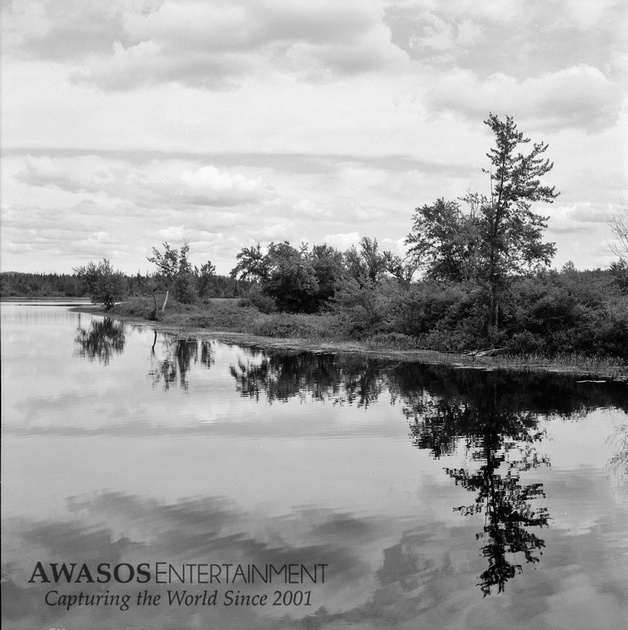 |
| Rolleiflex MX-EVS Type II, 75mm Tessar, Tupper Lake, NY |
Now yes, I know I could just set my dslr to manual and do a similar thing. It's not the same though. My digital is my bread and butter. I shoot with it to earn a living. When I want to shoot for fun, I want to remove myself from my "work" atmosphere. Switching to a film camera helps accomplish that. I enjoy the analog buttons, the woosh of a timer for slow speeds, the mechanical nature of my cameras. There's no battery to worry about. A watch repairman could probably fix almost anything on my cameras if push came to shove. There's no rush, no deadlines, no push to get the shot right. Just me exploring my world. That's not to say I won't use a film camera for work; They're a bunch of fun for portraits, landscapes and more. I've been published and exhibited work with both. It's just they're not the cameras that pay my bills. In fact, with the cost of film and processing (and time to scan) they cost me a fair bit.

|
| Cornelius Rose, Hasselblad 500cm, 80mm Planar |
I also find that there is a different feel, especially with medium format cameras. Yes I know I could get a digital back for the Hassey. Anyone have a spare $15,000 they want to give me? Same goes for my Leicas. I'd love to try an M9, but I don't love it $7,000. The changes in depth of field and feel with a larger format give me enough reason to keep shooting with my film cameras.
Low light? Well so what? Here's a shot at 1/8th of a second.
 |
| Klezmer Band, Mimi's in New Orleans. Leica M6ttl, 35mm Voigtlander f2.5 |
Sure, I get less keepers and I wouldn't want to shoot sports at that speed, but it's doable for a lot of situations. My prime lenses are easily a good stop and a half, two stops faster than the zooms I use with my digital. I can get away with shooting at ISO 400 or 800 with my Leica, whereas with my DSLR I'd be at 1600 or 3200 (or higher).
I guess what it comes down to, is I shoot what I like. and as long as I can get film, I'll continue to do so. While some may say it's bunk, I still say it feels different. And I like it that way.
(If you like what you see, consider supporting me by purchasing a print from my website. Photography is how I pay my bills, and contributions from good folks like you is what keeps me making my art possible) www.awasos.com
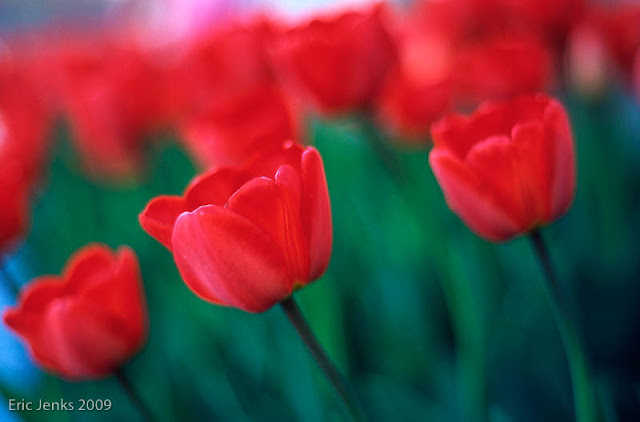
Walking around to today I felt the heat of the sun on my brow. Felt like the first time in a year, haha. Spring is coming. Another year of renewal and birth, of fresh ideas and fresh starts. I'm about to embark on a big trip down to New Orleans, a first for me. While I've been many places in the last few years, the Big Easy isn't one of them.
I'm a country boy. I grew up in the forest and generally my idea of a good time is embarking on a journey to places in the wild. Yellowstone was a great adventure in 2008. The last few years though, I've been observing the urban jungle, or at least the suburban jungle.
The scenes are completely different, but the feel is somewhat of the same. It's still an exploration of something unknown for me. The nature feels a bit contrived, but it's still there.
There's even something else that is fun to capture in cities; people.
They give an added dimension to the photos that would otherwise be missing. I love working them into nature scenes as well when possible.
I like people. They're fun to work with. Each and everyone of them responds differently to the camera. For the last few years, I've studied Henri Cartier Bresson, Paul Strand, Albert Eisenstaedt, André Kertész, Margret Bourke-White and a personal favorite Galen Rowell. It's a similar process that I've gone through in Jazz. You listen to others so that you can build your own vocabulary. And that's what I've been doing with my photography; building a language so that I can express myself. Express my views of the world.
I speak with my photos so I can capture a moment; I want people to see what things look like from my point of view and hopefully take advantage of the things around them. There is power in the everyday, in the normal as long as we take the time to look for it.
That's all for now folks, take care.

Snow and Ice. It's the great equalizer for a day. The white blanket evens out dips and rises in the landscape, and creates a sense of equality to a scene.
Street photography gets a bit tough in the winter; people tend to hunker down inside during storms, and in the cold weather. Your options become a bit more limited. But there's always someone out having fun.
Embrace the cold though, and go get some shots. It's a fun world in the snow. I find that I tend to shoot more black and white in the winter, the starkness of the atmosphere seems to call for it. But if you can find it, the juxtaposition of color in the shades of gray of a winter day can make a shot really stand out.
It's a very important thing while working (especially at a show with thousands of people and stage antics galore) to pay attention to your surroundings. A lot of photographers get tunnel vision while shooting - we focus on our main objective. But for safety's sake and for finding different shots, keep an eye out. You never know what is coming. Here, I wasn't paying close enough attention. During a show with a well known musician, you get two options - 3 songs or 15 minutes, depending on the artist. Sting was the worst - only allowed to shoot for 2 songs, from 100 + feet away :/. Paisley was better, but you had to fight a crowd of people to get your shots, even with a press pass. The only way to get a clear, full body shot was to shoot from the ego stage (a long, narrow stage that sticks out into the audience). While I was doing that however, I failed to notice his fiddle player coming right at me. He missed, but I felt the woosh of air as he passed. This was the shot I got as that happened.
So. Stay alert and have a good time shooting!
Cheers,
Eric
p.s. you can see more photos of the shoot from here - http://ericjenks.zenfolio.com/paisley
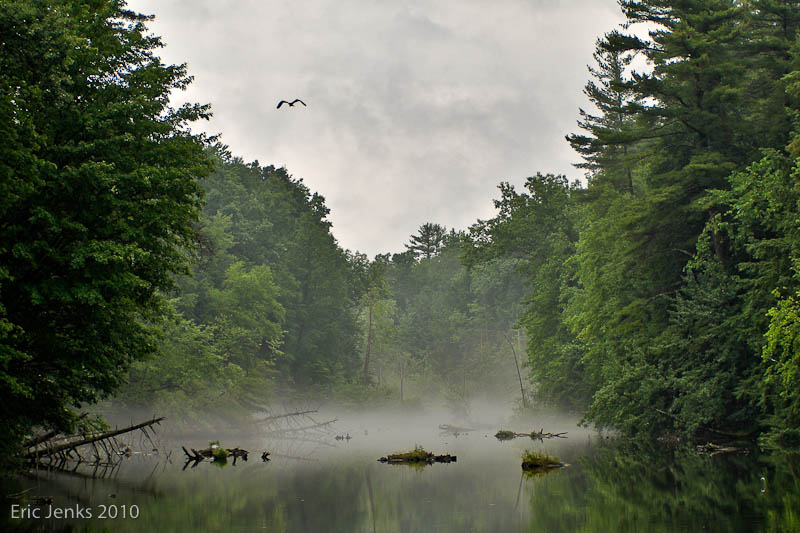
There are two main rules to photography assignments, at least in my mind.
1. Always have a camera
2. Get there early
I can not tell you how many times over the last two years some of my favorite work has been done by leaving for an assignment early, or sticking around afterwards for a little bit. It's usually when I get my landscape jones taken care of. I stop on the side of the road whenever I see something interesting. The above photo is an example of that from yesterday as I went to cover a festival in Wilton NY. As I was driving down the road I saw that the mist was still on the water. I pulled an Uee, parked on a blind curve and started to set up for the shot. before I could get out my tripod (but had camera on and in my hand) a great blue heron took off into the distance. I got three shots off in aperture mode still set wide open on the lens. Luckily focus was fast enough and Nikon's 3d matrix smart enough to capture the right exposure while I lined up the composition I had seen in my head while driving. A few minutes later I would have missed the whole thing, being in a rush to get to the assignment. So next time breath deep, sit fast and see what else is on the roadside for you. I'll leave you with one more that I took while waiting to sit in on a Town board meeting in Wells, NY last fall.
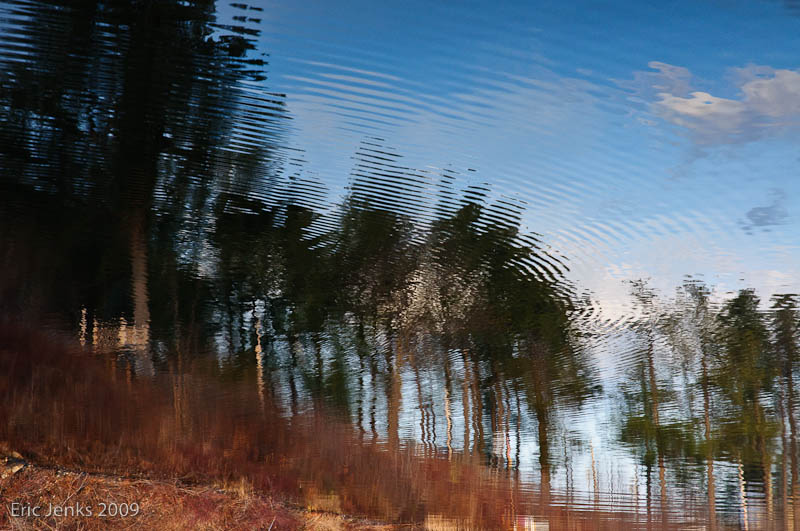 |
| From Landscapes and Nature Shots |
However, flash does have its uses sometimes. Shooting a show for the Scene the other day for example. Horrid lighting conditions. Here's the first shot out of the camera while I tried to figure out how the hell to light this thing.
 |
| From OFC, |
That is a horrid lighting situation right there. No real light on George Fletcher (right) a green light on the fellow to the left and a blown out background. The camera has given its best guess for the situation, thrown up its hands and said "hey there fella, this is why you get paid to do this thing. I'm out of here."
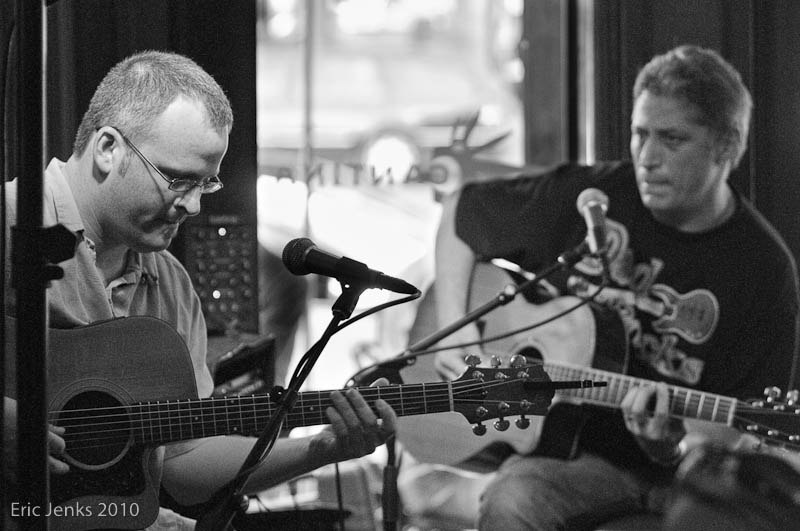 |
| From OFC, |
B&W and a bit of dodging and burning helps, but not when you're shooting for a color paper and need a cover shot.
 |
| From OFC, |
So lets move to flash on camera. Helps with the background, helps with the light on Georgie over there, but still not so much. It's harsh, too direct and I've lost detail in the guitar, the guitarists and it just looks flashed. No go on this one Capitan. What now? Well in looking around I see this tiny itty bitty shelf. Just large enough to set my flash on with its little stand. Plunk it in wireless mode, set the mood a bit by reducing its output a bit from the camera and go from there.
 |
| From OFC, |
Badabing Johnny! Background is controlled and so is the light. Just looks like another spot light in the room. Shoot to your heart's content (or the batteries in your flash or the annoyance of the musicians/customers in the place) get your shots and get out of dodge. Ittl lighting to the rescue. While I did use an SB900 for this, the shot could be done with any wireless strobe (I have an SB80dx I paid a whopping $80 for). The difference? Set-up time. I got the SB900 set up in 10 seconds. Would have taken a couple of minutes of futzing with the SB80 to get the light right.
So saddle up, get that light off camera for the love of all that's holy and shoot something (with your camera. Or at a firing range. Your choice really)
Over and out,
Eric
 |
| From Fall 2009 |
 |
| From Fall 2009 |
 |
| From Fall 2009 |
This shot is one of my favorites from the track -
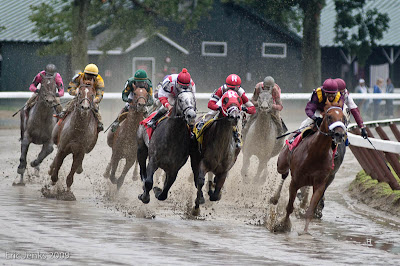 |
| From Saratoga Track |
It's another that is a behind the scenes. Take this one from a race slightly earlier
 |
| From Saratoga Track |
It's good, but not great. The difference? Take a look at the background. This is what viewers at the track get to see. All the cars, outhouses and other muck. You don't notice it live - your focus is on whether horse-glue sally is going to pull out the win with Jockey Elmer on her back. But it makes a world of difference in a photo, where your eye has time to survey the whole scene, and you're not wondering whether you just lost ten bucks. But with a little piece of track issued plastic (the track is a little more strict), a walk like you own the place and a quick nod to the security guard as you pass, you get to shoot with the stalls in the background. Great isn't it?
Eric
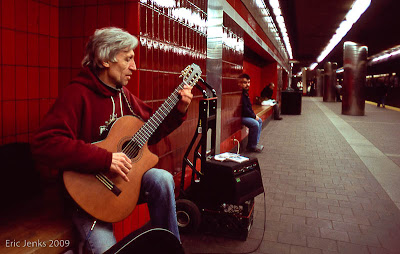
One of my favorite musician photos, that I shot in the Boston subway system in February 2009. I used an F100 body - arguably a very expensive piece of kit for its day, though relatively cheap now. But the lens; that's a different story. The lens is an old tamron adaptall manual focus jobber, and costs about $100 if you shop around, maybe even less. At 24mm and f2.5 it's faster than Nikon's 24mm f2.8 yet hundreds less in terms of cost. It's a sharp little bugger without much distortion too. I love it for shooting in lowlight, landscapes and more. A good all around lens. I actually got it for free from a friend.
These next two shots prove the point as well
  |
| From Fall 2009 |
My point here is this - you don't have to spend a fortune on gear to get good results. It's applicable with modern digital camera bodies, old film gear and anything in between. Some of my favorite lenses date all the way back to the mid thirties, and cost me less than $100.
I rarely spend thousands of dollars on gear. Do I? Yes there are occasions where for me to get a shot, I pull out a lens that I've spent several hundred dollars on, and my digital bodies have ranged in price from $900-$1400. Ouch. Still haven't hit that $1000 mark with a lens thankfully. However some of my favorite shots are done with old lenses, or with modern lenses that I haven't spent a boatload on. I advocate endlessly for beginners and old timers alike to try out these old lenses before going to the modern super zoom, or other consumer lens of today.
Why primes over zooms you may ask? Because
a. That 135 f3.5 is plenty fast for daylight and landscape shooting, yet weighs a ton less than my 80-200 f2.8. Same goes for the 24mm versus my 17-35 f2.8. You can only carry those two big lenses so far before your body starts crying out from the strain. Hour after hour, day after day, it gets to you. Also it's still faster than any kit lens from today as well, offering more control over depth of field. Same goes for getting the wonderful plastic fantastic 50mm f1.8 AF. It's cheap used (I paid a whopping $30 for mine when I had it, though now they're around $80-100) and the low light AF and shutter speed of that lens compared to a kit 18-55 is incredible. Once you get used to having a sharp lens that lets you control depth of field and shoot at night, you'll never turn back.
b. I believe that having a single focal length to deal with will teach a beginner more than a zoom. You learn so much more about composition using a single lens where you're forced to walk around, look at different angles and consider the perspective in comparison to the lazy attitude most people have with zooms. One focal length eliminates a variable, allowing you to focus on shutter speed, aperture and ISO. If you leave your ISO set to one setting, this gets you down to two variables to deal with. Much better than four when you're trying to learn the basics of photography isn't it?
c. They're fun! Really. Going out for a day to shoot with a bag that weighs less than 20 lbs is great. I feel free and enjoy myself a lot more. At the same time however, I know I'm using something that will give me great image quality and a look that can't be matched by the zoom happy crowds of today.
d. They're cheap! Have I said that enough yet? They're stinking cheap for the cost to function ratio, and let you try a whole new field of photography in comparison to modern kit zooms. Old manual lenses do lose a bit of use on some modern digital cameras. Nikon, Olympus and Pentax however all share some functionality with their older MF lenses. Canon can take a lot of other lenses from different manufacturers (Nikon and Pentax for example) but aren't backward compatible with their own MF lenses. While you may lose metering, you can guess, use an external meter or use the sunny 16 rule and get fairly accurate results. With modern DSLRs, you can always check your exposure with the histogram and the LCD screen on the back. You feel a bit like you're naked the first time shooting without a meter. It's exhilarating really. Almost like streaking across a busy street. Not that I've done that or anything =oP. You'll start reading light more, thinking about the scene and how the shadows and highlights will change the composition. It's a great thing to know.
(P.S. Old film cameras are cheap!!! You can pick them up for a song, load them with film and shoot to your hearts content, and still have hundreds left in the bank in comparison to the cost of a good digital. Give it a try, you might be surprised at the results).
So folks give it a shot! Go out and shoot with something that costs less than a $100. Live on the edge and go naked through the streets (figuratively of course.) Enjoy the art, not the gear.
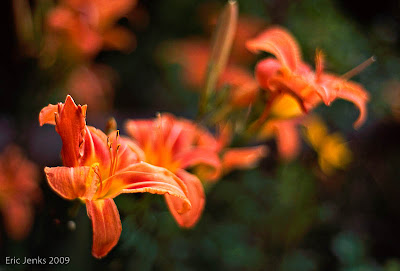 |
| From Landscapes and Nature Shots |
Eric
First, a bit about me. I'm a photographer from Saratoga Springs NY, and I have been actively photographing events and exploring the Adirondacks for the last six years. I have been published in National Geographic Adventure, Saratoga Living, the Skidmore College newspaper Skidnews and have had video work on PBS. Some of my current freelance work can be seen in the Hamilton County News, Saratoga Living, and in many Saratoga based publications the Ballston Spa Life, The Scene, The Saratogian, and the Wilton-Gansevoort Life. My video products are done in association with On Track Production, some of which can be scene at http:www.ontrackproduction.com. I had my first gallery opening back in May 2007, and currently have work in Divinyl Revolution in downtown Saratoga and Mountain Memories in Wells, NY. Right now, I'm just looking to do whatever makes me happy. As the saying goes, follow your bliss and the rest will follow.
I'm sure I'll post more soon, but this will be good for a first go about.
Cheers,
Eric








